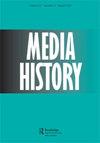A Clash of Ideals
IF 0.4
Q4 COMMUNICATION
引用次数: 1
Abstract
In 1969, a government report concluded that there was a need for closer contact between the citizens and Swedish government agencies. Television, at this time still considered a new medium, was highlighted in the report as a valuable form of mass communication with great yet unfulfilled promise as a disseminator of government information. A heated debate about the role and function of government information ensued, not least within the public service broadcaster Sveriges Radio. While much research has been devoted to the Swedish public service model, little is known about Swedish television’s function as a communication tool for government authorities. The article shows that the discursive struggles surrounding Swedish government agencies’ use of television centered on three main issues: public service broadcasting’s independence, the dangers related to one-way mass communication, and the shape and aesthetics of government information. By shedding light on the introduction of the program Anslagstavlan, this article contributes to a previously forsaken media history of televised information.理想的冲突
1969年,一份政府报告得出结论,认为公民和瑞典政府机构之间有必要加强联系。电视在当时仍被视为一种新媒介,报告强调它是一种有价值的大众传播形式,在传播政府信息方面具有巨大但尚未实现的希望。随之而来的是一场关于政府信息的作用和功能的激烈辩论,尤其是在公共服务广播公司Sveriges Radio内部。虽然对瑞典公共服务模式进行了大量研究,但对瑞典电视作为政府当局沟通工具的功能知之甚少。文章表明,围绕瑞典政府机构使用电视的话语斗争集中在三个主要问题上:公共服务广播的独立性,与单向大众传播相关的危险,以及政府信息的形状和美学。通过对Anslagstavlan节目的介绍,本文对先前被遗忘的电视信息媒体历史做出了贡献。
本文章由计算机程序翻译,如有差异,请以英文原文为准。
求助全文
约1分钟内获得全文
求助全文

 求助内容:
求助内容: 应助结果提醒方式:
应助结果提醒方式:


